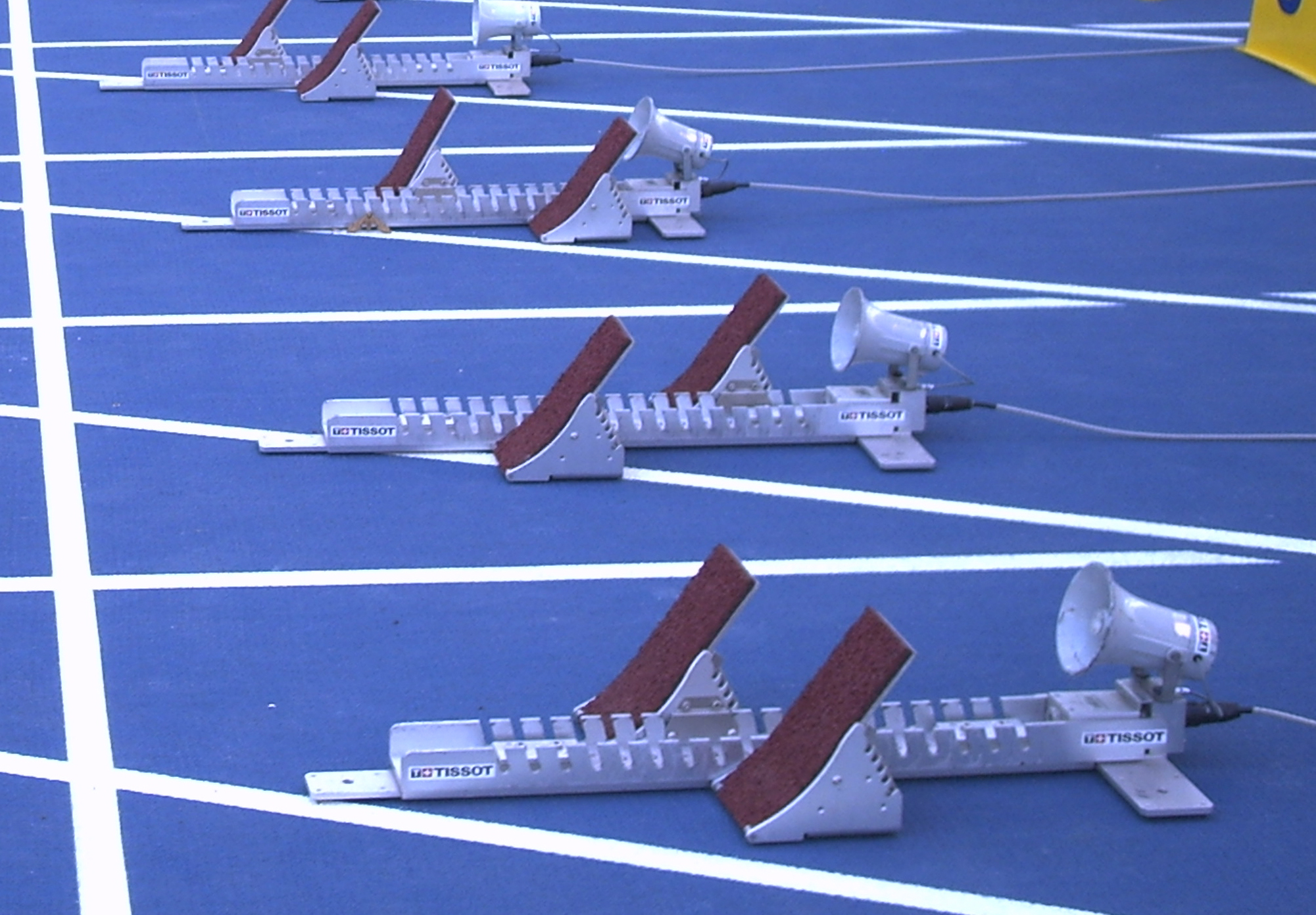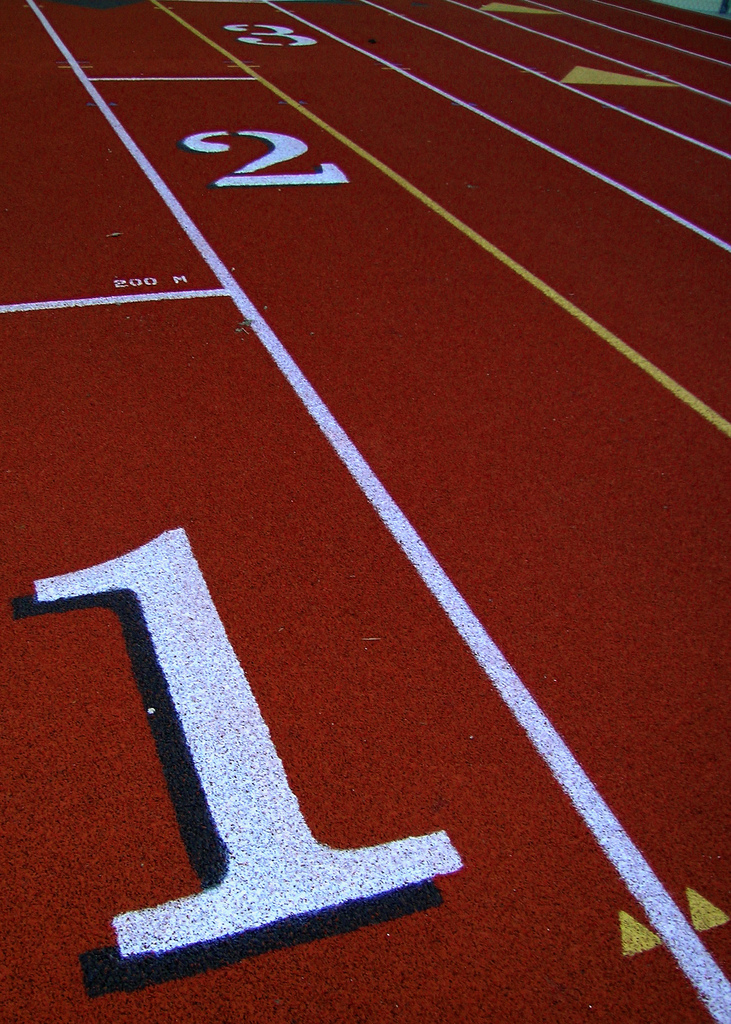|
Starting Blocks
Starting blocks are a device used in the sport of track and field by Sprint (running), sprint athletes to brace their feet against at the start of a race so they do not slip as they stride forward at the sound of the starter's pistol. The blocks also enable the sprinters to adopt a more efficient starting posture and Isometric exercise#Isometric presses as preparation for explosive power movements, isometrically preload their muscles in an enhanced manner. This allows them to start more powerfully and increases their overall sprint speed capability. For most levels of competition, including the whole of high-level international competition, starting blocks are mandatory equipment for the start of sprint races. IAAF Rule 161 Their invention is credited to Australian Charlie Booth and his father in 1929. Prior to this, runners would dig holes in the dirt track. Trowels were provided at the start of races. This was not the most consistent or stable system. It also was destructive to ... [...More Info...] [...Related Items...] OR: [Wikipedia] [Google] [Baidu] |
Sport Of Athletics Terminology
Sport is a physical activity or game, often competitive and organized, that maintains or improves physical ability and skills. Sport may provide enjoyment to participants and entertainment to spectators. The number of participants in a particular sport can vary from hundreds of people to a single individual. Sport competitions may use a team or single person format, and may be open, allowing a broad range of participants, or closed, restricting participation to specific groups or those invited. Competitions may allow a "tie" or "draw", in which there is no single winner; others provide tie-breaking methods to ensure there is only one winner. They also may be arranged in a tournament format, producing a champion. Many sports leagues make an annual champion by arranging games in a regular sports season, followed in some cases by playoffs. Sport is generally recognised as system of activities based in physical athleticism or physical dexterity, with major competitions admi ... [...More Info...] [...Related Items...] OR: [Wikipedia] [Google] [Baidu] |
Christmas Tree (drag Racing)
Modern drag racing, drag races are started electronically by a system known as a Christmas tree. A common Christmas tree consists of a column of seven lights for each driver or lane. Each side of the column of lights is the same. At an NHRA national event, the Christmas Tree, which was first used in April 2011, from the top down, consists of a blue LED light set (top and bottom halves), then three amber bulbs, then a green bulb and a red bulb. At other events, and NHRA national events prior to 2011, the function of the blue light set was performed by four smaller amber bulbs. The lights are activated after the drivers are properly staged on the starting line by interrupting a set of two Photoelectric sensor, light beams across the track itself. One set is on the starting line, and the other set sits behind it. Light sequence Blue or small amber lights (staging) When drivers are preparing to race, they move the vehicle and interrupt light beams behind the starting line. Crossin ... [...More Info...] [...Related Items...] OR: [Wikipedia] [Google] [Baidu] |
Athletics At The 1956 Summer Olympics – Men's 800 Metres
The men's 800 metres event at the 1956 Summer Olympics in Melbourne was held on 23, 24, and 26 November 1956. There were a total number of 38 competitors from 24 nations. The maximum number of athletes per nation had been set at 3 since the 1930 Olympic Congress. The event was won by Tom Courtney, the last of a streak of four American victories in the event and the seventh overall United States victory. Derek Johnson's silver put Great Britain back on the podium for the first time since that nation's own four-Games gold streak ended in 1932. Norway received its first men's 800 metres medal with Audun Boysen's bronze. Summary This one Olympiad saw the use of starting blocks from a waterfall start for the 800 meters. All subsequent races have used a standing start in lanes, breaking after the first turn (known as a one turn stagger). Out of the blocks, Tom Courtney got the edge around the turn, but by the end of the turn Arnie Sowell edged into the lead. Over the next 150 ... [...More Info...] [...Related Items...] OR: [Wikipedia] [Google] [Baidu] |
400 Meters
The 400 metres, or 400-meter dash, is a sprint event in track and field competitions. It has been featured in the athletics programme at the Summer Olympics since 1896 for men and since 1964 for women. On a standard outdoor running track, it is one lap around the track. Runners start in staggered positions and race in separate lanes for the entire course. In many countries, athletes previously competed in the 440-yard dash (402.336 m)—which is a quarter of a mile (1,760 yards) and was referred to as the "quarter-mile"—instead of the 400 m (437.445 yards), though this distance is now obsolete. Like other sprint disciplines, the 400 m involves the use of starting blocks. The runners take up position in the blocks on the "ready" command, adopt a more efficient starting posture which isometrically preloads their muscles on the "set" command, and stride forwards from the blocks upon hearing the starter's pistol. The blocks allow the runners to begin more po ... [...More Info...] [...Related Items...] OR: [Wikipedia] [Google] [Baidu] |
False Start
In sports, a false start is a disallowed start, usually due to a movement by a participant before (or in some cases after) being signaled or otherwise permitted by the rules to start. Depending on the sport and the event, a false start can result in a penalty against the athlete's or team's field position, a warning that a subsequent false start will result in disqualification, or immediate disqualification of the athlete from further competition. False starts are common in racing sports (such as swimming (sport), swimming, Track and field, track, Sprint (running), sprinting, and motor sports), where differences are made by fractions of a second and where anxiety to get the best start plays a role in the athletes' behavior. A race that is started without a false start is referred to as a ''fair start'' or ''clean start''. In sports Association football (soccer) Football games cannot be restarted unless certain conditions are met. For example, both teams need to be in their ... [...More Info...] [...Related Items...] OR: [Wikipedia] [Google] [Baidu] |
Tartan Track
Tartan track is a trademarked all-weather synthetic track surfacing made of polyurethane used for track and field competitions, manufactured by 3M. The original production was in 1967, and the product was later reformulated to eliminate the use of mercury. Because the "Tartan" product was widely successful in its time, the name Tartan has been used as a genericized trademark for description of an all-weather running track. Athletic Polymer Systems, a subsidiary of MCP Industries, Inc., manages the installation of Tartan-branded running track. History According to Minnesota Mining and Manufacturing ( 3M), developed its "Tartan" track and turf products in the late 1950s, and ''Sports Illustrated'' called its development a breakthrough in 1963. The track product was made for running and horseracing tracks and the turf was made for stadiums. These were the first man made track and turf for athletics. Tartan track was tested for use at a track and field competition in the Los ... [...More Info...] [...Related Items...] OR: [Wikipedia] [Google] [Baidu] |
Nick Newton
Milton "Nick" Newton (November 6, 1933, in Tarboro, North Carolina, United States – March 31, 2018, in Palm Springs, California) was the inventor of the Newton Starting Blocks. Newton blocks are considered by many to be the best in the world, used at many major track meets like the Mt. SAC Relays. Starting blocks are the device sprinters use to hold their feet at the start of a race so they do not slip as they push out at the sound of the gun. Using his experience as a tool and die maker for Waste King, Newton invented a cast aluminum block design as an improvement for his daughter Pam, who was excelling in girls' track. Newton's solid, but lightweight versions greatly improved on the flimsy or rusty old devices that had been standard equipment for decades. Obtaining his first patent in 1978 Newton has subsequently patented two additional innovations to offer sprinters more possible settings to prepare for their start. He became heavily involved as a mentor for the L.A. Mer ... [...More Info...] [...Related Items...] OR: [Wikipedia] [Google] [Baidu] |
Track And Field
Track and field (or athletics in British English) is a sport that includes Competition#Sports, athletic contests based on running, jumping, and throwing skills. The name used in North America is derived from where the sport takes place, a running track and a grass field for the throwing and some of the jumping events. Track and field is categorized under the umbrella sport of athletics, which also includes road running, cross country running and racewalking. Though the sense of "athletics" as a broader sport is not used in American English, outside of the United States the term ''athletics'' can either be used to mean just its track and field component or the entirety of the sport (adding road racing and cross country) based on context. The foot racing events, which include sprint (running), sprints, middle-distance running, middle- and long-distance running, long-distance events, racewalking, and hurdling, are won by the athlete who completes it in the least time. The jumpin ... [...More Info...] [...Related Items...] OR: [Wikipedia] [Google] [Baidu] |
100-yard Dash
The 100-yard dash is a track and field sprint event of . It was part of the Commonwealth Games until 1970, and was included in the triathlon of the Olympics in 1904. It is not generally used in international events, replaced by the 100-metre sprint (109.36 yards). However, it is still occasionally run in the United States in certain competitions; in the NCAA championships it was last run in 1975. Walter Halben Butler (1852–1931) is credited with being the first to run the race in 10 seconds. All-time top 25 ''Automatic timed results only.'' *+ = en route to 100 m performance *A = affected by altitude *nw = no wind measurement Men *Updated in August 2023. Notes Below is a list of other times equal or superior to 9.37: * Asafa Powell also ran 9.09 (2010), 9.26 (2015), 9.27 (2013). * Charles Greene also ran 9.23 (1967). *Usain Bolt Usain St. Leo Bolt (; born 21 August 1986) is a Jamaican retired sprinter who is widely regarded as the greate ... [...More Info...] [...Related Items...] OR: [Wikipedia] [Google] [Baidu] |
George Simpson (sprinter)
George Sidney Simpson (September 21, 1908 – December 2, 1961) was an American sprinter. He competed at the 1932 Olympics and won a silver medal in the 200 m, placing fourth in the 100 m event. Simpson was the first to run 100 yards in 9.4 seconds, but because he used starting blocks, the record was never ratified. He won the in both NCAA The National Collegiate Athletic Association (NCAA) is a nonprofit organization that regulates College athletics in the United States, student athletics among about 1,100 schools in the United States, and Simon Fraser University, 1 in Canada. ... and AAU in 1930. He was also fourth in the 100 meters at the 1932 Olympics. In 1929 he unofficially equaled the 200 meters World Record 20.6 seconds. Simpson attended Ohio State and won a national title in 1929. Competition record References 1908 births 1961 deaths Ohio State Buckeyes men's track and field athletes Athletes (track and field) at the 1932 Summer Olympics American ma ... [...More Info...] [...Related Items...] OR: [Wikipedia] [Google] [Baidu] |




